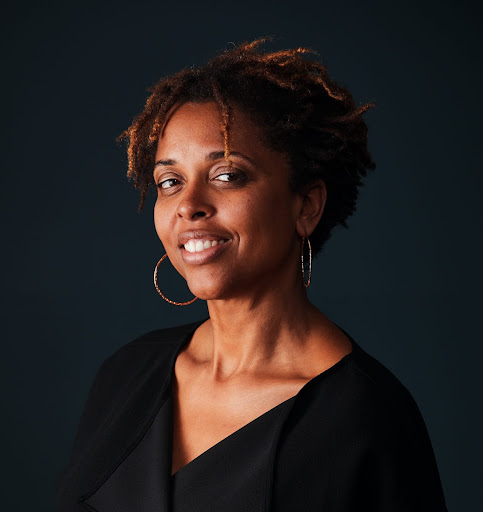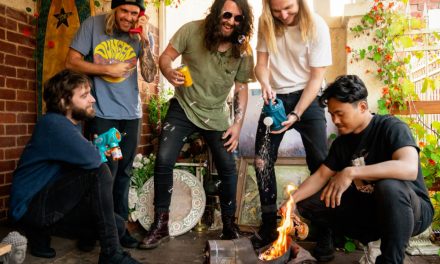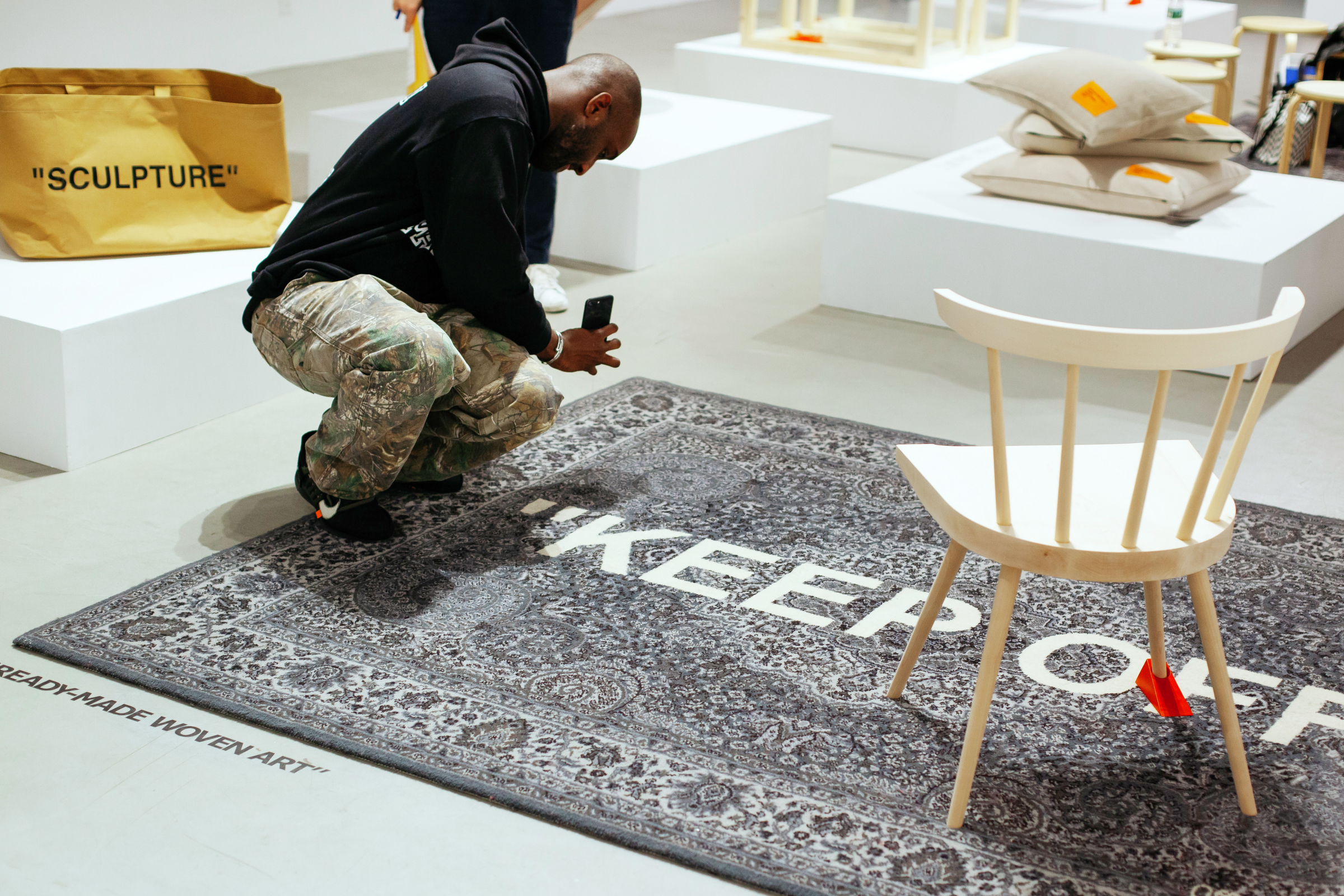“I searched for traces of me and for memories in front of me through Indigo, through dance, through food and through familiar spaces and faces. I landed in a village of women who were keeping Indigo in The Gambia. And they looked like me.”
Atlanta-based artist Charmaine Minniefield offered the audience a behind-the-scenes look at her new body of work, “Indigo Prayers: A Creation Story,” at the Carlos Museum’s Ackerman Hall on March 30. Minniefield created the project during her time in The Gambia in the beginning of the COVID-19 pandemic.
Titled “Sovereign,” “Wisdom,” “Abundant,” “Freedom,” “Love,” “Peace” and “Eternal,” the series of self-portraits that make up “Indigo Prayers” are captivating. I felt as though I could hear the paintings — they are massive and filled with commanding strokes of a vivid blue hue. Spread across three walls, you have to turn corners as you take all of them in, a motion that seems to echo the counterclockwise dance of the women in the ring shout. Each work depicts movement, with the figure’s arms stretched out, neck bent or head tilted. They appear to be both moving and sitting still in time. The plaque describing the work begins: “What if seven Black women spinning counterclockwise, each upholding a single attribute of God, conjured creation?”
Minniefield revealed that the title of each painting is an attribute she wishes to see for herself — a powerful reclamation.

Courtesy of Charmaine Minniefield.
“I wanted to be abundant,” Minniefield said. “I wanted to be eternal. I knew that I was sovereign. That I should have the right to my own body, my own land, my own memories, my own institution.”
In “Peace,” the painting with the most negative space in the background, the color scheme is inverted. Here, the dramatic splashes of blue and red make it look like a figure is emerging from the background, like a rebirth.
In “Eternal,” I kept seeing more faces the more I looked. Step closer, and you find yourself engrossed in the faces. Step back, and you can see the flashes of limbs reaching out. In some works, there are slivers of white shadows around the figure that are halo-like.
“Sovereign” is quietly explosive. The woman in the artwork has a red arm and a heart-shaped face. Words like “wild woman,” “rememory” and “remembrance,” play in my head, reminding me of themes in Toni Morrison’s writing, who Minniefield cites as one of her inspirations.
Minniefield’s work is inspired by Indigenous traditions from Africa and the diaspora. Her art explores African American history, memory and ritual as resistance against Black erasure and draws from womanist social theory, a form of feminism focused on the experiences of Black women.
The Praise House Project is a public art installation that celebrates the Ring Shout, a traditional African American movement and worship that was performed by enslaved people in structures called praise houses — safe spaces to recall and affirm their identity. Minniefield set up her first praise house at Oakland cemetery to honor the 800 unmarked graves in the African American Burial Grounds at the cemetery. She received a grant from the National Endowment for the Arts to present her project at three different locations across Atlanta: South-View Cemetery, downtown Decatur and Emory University’s Atlanta campus. Additionally, she was a Stuart A. Rose Library artist-in-residence at the University in 2019 and 2020.
Initiating the talk with a ceremony, audience members called out the names of ancestors, to which everyone responded, “Ashe,” a word of affirmation said at the end of prayers, originating from the Yoruba language.
“We’re giving honor to the ancestors that once gave love and care to this earth,” Minniefield said.
When talking about her inspiration, she said that movements like Black Lives Matter directly feed into her work. “Indigo Prayers” furthers Minniefield’s exploration of the Ring Shout while reckoning with the impact of these world events.
“My grandmother reminded me what we would do in the worst of times: We would pray,” Minniefeld said. “We wouldn’t just say words. We let that prayer move through our entire body, and it lifted us onward; it affirmed our life at the moment of remembering our identity. And, as lives were being taken on these streets, I remembered her prayer.”
Minniefield connected with her history and community in The Gambia, saying that she “romanticized and created intricate myths of [her] family,” and tried to tell their stories through her art.
The artist compared the difference in the experience of the Ring Shout ceremony in The Gambia with how she knows it in her own context.
“They swing their arms like hummingbirds, so fast you can hardly see their arms,” Minniefeld said. “And their knees are up high. Ours are the same movements exactly, but our hips [are] restrained, our feet shuffle, our knees don’t get high because of our circumstances.”
Minniefield described the creation of the work itself as a ritual. Because she did not have access to pigment or canvas in The Gambia and had to look for other means, she used indigo, an Indigenous pigment that traveled to the West alongside slavery, labor and trade skills. She also made other pigments using mahogany bark and crushed oyster shells.
Minniefield says she hopes to accomplish historic preservation with every praise house that is created and create community-specific technology to digitize collections and preserve historic spaces. Minniefield actively reclaims and re-centers Black narratives in the face of Confederate memorials and acts of erasure. Her art pushes back unapologetically, taking ownership of physical and emotional spaces.
Minniefield’s fierce determination to spread her art as far as she can is inspiring. Her creations are living works of art in charge of writing their own history.
“Indigo Prayers: A Creation Story” runs March 19 to Sept. 11 at the Carlos Museum.
Mitali Singh (she/her) (25C) is studying English, creative writing and psychology. Her poems have been published in Eunoia Review and FEED.
She feels most inspired while spending time outdoors and loves immersing herself in different forms of art.






